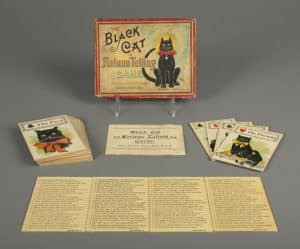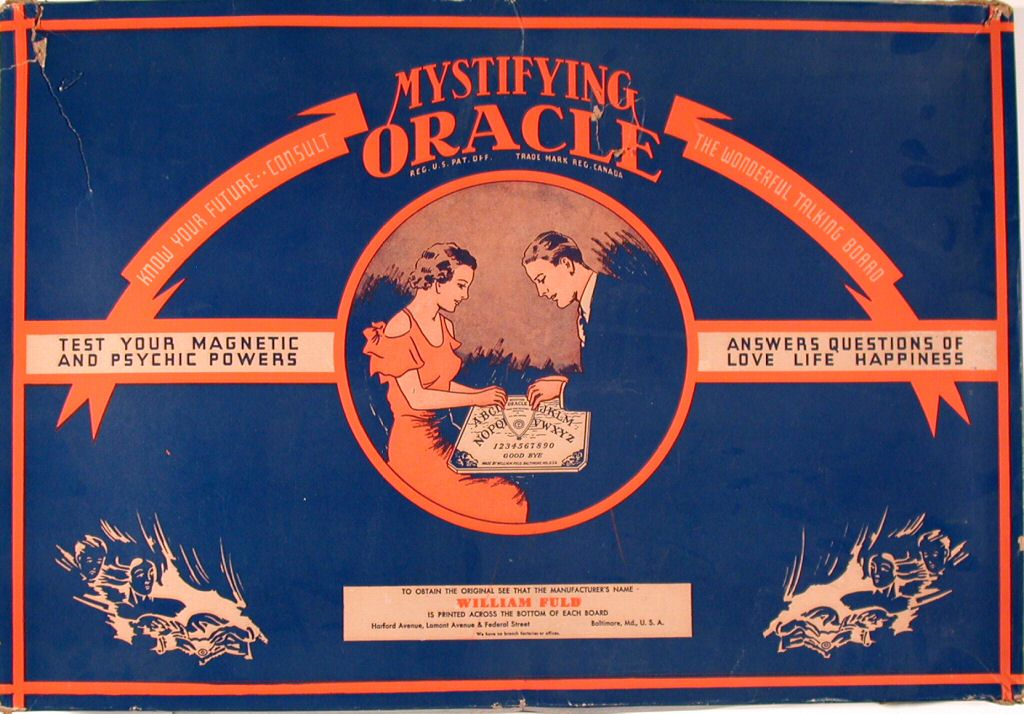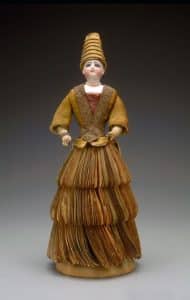What will your life look like a year from now? Most of us are intrigued—just a bit—to know what the future holds for us, curious about how our careers, relationships, or finances will go. We’re certainly not the first to wonder about such things, nor will we be the last. For centuries, people of all cultures have pondered the same questions and devised a variety of ways to predict the answers. Some scholars believe the origins of fortune telling can be traced to 14th-century gypsies, while others believe the roots of divination and prophecy run much deeper. In my case, it didn’t take a crystal ball to help me discover more about the artifacts related to fortune telling; a look into the collections at the National Museum of Play at The Strong revealed a variety of popular fortune-telling games and toys.
 Perhaps one of the most famed fortune tellers was Marie Anne Lenormand of France. Lenormand practiced divination as an acclaimed professional for more than 40 years, advising many including the illustrious Empress Josephine—wife of Napoleon Bonaparte. Lenormand also published a variety of controversial texts during the 19th century, many of which earned the legendary soothsayer brief stays in jail. Lenormand died in 1843, but her legacy lives on with a 36-card divination deck bearing her name that is still used in parts of the world today, sometimes in conjunction with Tarot cards. Popular game manufacturer McLoughlin Brothers released its own version of the deck, Lenormand’s Mystic Cards of Fortune, in 1887. Rival company Parker Brothers produced fortune telling cards, first The Fortune Telling Game in 1890, followed by the Black Cat Fortune Telling Game in 1905, wherein printed cards are laid out categorically, with a single line of text aligning across four cards, revealing one’s fortune.
Perhaps one of the most famed fortune tellers was Marie Anne Lenormand of France. Lenormand practiced divination as an acclaimed professional for more than 40 years, advising many including the illustrious Empress Josephine—wife of Napoleon Bonaparte. Lenormand also published a variety of controversial texts during the 19th century, many of which earned the legendary soothsayer brief stays in jail. Lenormand died in 1843, but her legacy lives on with a 36-card divination deck bearing her name that is still used in parts of the world today, sometimes in conjunction with Tarot cards. Popular game manufacturer McLoughlin Brothers released its own version of the deck, Lenormand’s Mystic Cards of Fortune, in 1887. Rival company Parker Brothers produced fortune telling cards, first The Fortune Telling Game in 1890, followed by the Black Cat Fortune Telling Game in 1905, wherein printed cards are laid out categorically, with a single line of text aligning across four cards, revealing one’s fortune.

Other fortune-telling games arrived on the market around the turn of the century, perhaps none more iconic than the Ouija board. The famous alphanumeric “talking board,” as the form was known, received its introduction to the American public in 1890. Although Ouija later became available as a card game, the original board and planchette version—once called the Mystifying Oracle—remains the most popular.
 Prefer a less “spirited” method of predicting the future? You have other options to choose from. How about a 19th-century fortune-telling doll? Unfold a page from her skirt, formed from sheets of printed, folded paper, and learn what fate has in store for you. Or perhaps a Magic 8 Ball is the way to go? Despite receiving not one, but two for my eighth birthday, I never really warmed to the molded-plastic billiard ball. I was always left with far too many questions because the answers the ball provided never seemed quite specific enough and, of course, some responses proved just plain bothersome. (“Ask Again Later.” What!?)
Prefer a less “spirited” method of predicting the future? You have other options to choose from. How about a 19th-century fortune-telling doll? Unfold a page from her skirt, formed from sheets of printed, folded paper, and learn what fate has in store for you. Or perhaps a Magic 8 Ball is the way to go? Despite receiving not one, but two for my eighth birthday, I never really warmed to the molded-plastic billiard ball. I was always left with far too many questions because the answers the ball provided never seemed quite specific enough and, of course, some responses proved just plain bothersome. (“Ask Again Later.” What!?)
If you favor a more sporadic, organic style of fortune telling that won’t take up much shelf space in your home, perhaps tea leaves or fortune cookies make a good fit. Whether it’s good news or not quite what you’d hoped for, at least you’ll have a comforting cup of tea to sip or a buttery cookie to munch while you ponder the results.
Ouija board, Magic 8 Ball, or fortune cookie—my limited psychic powers certainly don’t allow me to predict which one you’d choose, But whether you prefer to be surprised or to know every detail in advance, the word “future” will probably always raise a question or two for most of us. I can’t help wonder what sort of fortune-telling cards and games manufacturers will come up with next? Something tells me Madame Lenormand would know.
 Hours 10 a.m.–5 p.m. | Fri. & Sat. till 8 p.m.
Hours 10 a.m.–5 p.m. | Fri. & Sat. till 8 p.m.